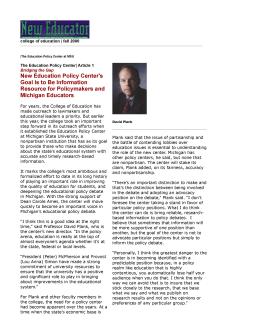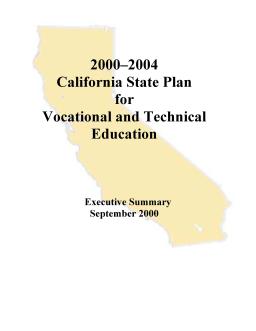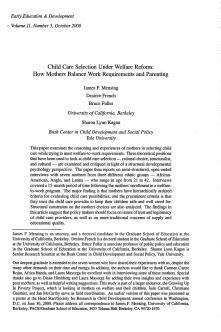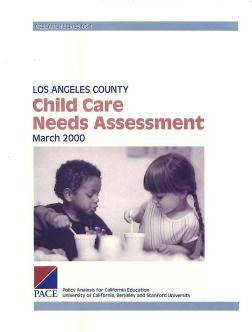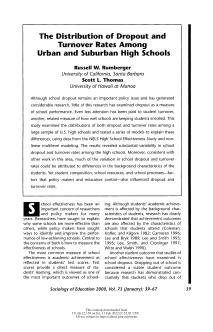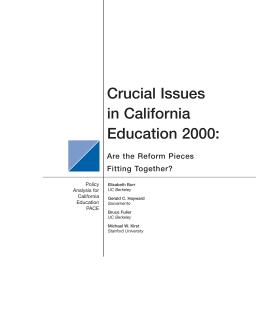New Education Policy Center's Goal Is to Be Information Resource for Policymakers and Michigan Educators
Published
Summary
Michigan State University's College of Education has established the nonpartisan Education Policy Center to provide lawmakers and educational leaders with accurate, research-based information to improve the state's educational system. With the support of the university's resources, the center aims to play an important role in deepening the policy debate and bringing about improvements in the system. The center was established due to a lack of systematic communication between researchers and policymakers in Michigan.
Executive Summary
Published
Summary
The California State Plan for Vocational and Technical Education 2000-2004 was developed with PACE's help, linking vocational education to other aspects of California's education system. The plan aimed to improve academic learning through strong vocational programs and better linkages between the world of schooling and the world of work. The summary covers the plan's context, guiding principles, vocational education, accountability, evaluation, and Tech-Prep Education.
How Mothers Balance Work Requirements and Parenting
Published
Summary
This paper examines how mothers select childcare to meet welfare-to-work requirements. Interviews with seven mothers from different ethnic groups show that trust in childcare providers to keep their children safe is the most important criterion. Structural constraints on their choices are also analyzed. The findings suggest that policymakers should focus on trust and legitimacy of childcare providers in addition to supply and educational quality.
Published
Summary
Governments are expanding the availability of portable child-care vouchers to boost working parents' purchasing power, rather than simply building more child-care facilities. Despite this, parents in poor communities still have limited choices due to cost and supply. Many eligible parents are not using subsidies, resulting in high out-of-pocket expenses for child care. Low-income working mothers make tough choices, working more hours or relying on informal providers, resulting in several transitions for children throughout the week, which experts suggest is not good for young children.
Published
Summary
A study conducted for the Los Angeles County Department of Public Social Services aimed to determine the supply and demand of licensed childcare in the county, with a focus on low-income communities and special types of care. The survey analyzed data at three levels: county-wide, service planning areas, and supervisorial districts. Results showed disparities in childcare supply across the county, with shortages in special types of care and little information on where childcare is needed.
Mothers Balance Work and Child Care Under Welfare Reform—Executive Summary
Published
Summary
A four-year study aimed to learn how welfare reform affects children's upbringing and development, showing early warning signals such as low-quality childcare and social isolation among women. The report provides a baseline picture for 948 families across three states and suggests an unfinished agenda for cash assistance and family support programs to lift children out of poverty.
Are the Reform Pieces Fitting Together?
Published
Summary
"Crucial Issues in California Education 2000" is a PACE publication that offers an analytical overview of California education through in-depth research projects contributed by experts statewide. It provides the latest data analysis and overall strategic recommendations on a wide variety of issues, from childcare to universities, making it a unique source for policy analysis. The volume is the largest in the history of the series, bringing together numerous reports on components of California education in one source.
Published
Summary
The reauthorization of the Elementary and Secondary Education Act provides an opportunity to reconsider the federal role in teacher professional development. The largest federal professional development fund is the Eisenhower program. Lessons from Eisenhower and contemporary research suggest that federal funds should be focused exclusively on subject matter knowledge and pedagogy and accountability should be based on assessment of student learning. The purpose is to generate discussion on how to more effectively use federal dollars to improve student achievement.
Published
Summary
This paper examines high school dropout and turnover rates in the US and tests models to explain the differences using data from the NELS High School Effectiveness Study. Variability was found among high schools, with much of the variation attributed to differences in student characteristics, but factors such as school resources and processes also influenced rates. Dropout and turnover rates are measures of school performance that policymakers and educators can influence.
Are the Reform Pieces Fitting Together?: Executive Summary
Published
Summary
California’s education system has undergone many reforms, with new mandates from policymakers threatening to overwhelm educators. The new accountability system tracks schools’ effectiveness and allocates carrots or sticks. Schools still struggle with reducing class sizes and finding enough qualified teachers. While California has made significant policy initiatives, the challenge is whether the puzzle pieces of reform fit together into a coherent “theory of action.” The issue of policy coherence must be addressed to energize teachers and bring forth more stimulating classrooms and pedagogy.
The Influence of Family Structure, Parental Practices, and Home Language
Published
Summary
Latino children are less likely to be enrolled in preschools, even after considering household income and maternal employment. Social factors such as language, child-rearing beliefs, and practices also impact center selection. African American families participate at higher rates, while lower enrollment for Latinos is linked to Spanish-speaking households and cultural preferences. Center selection is part of a broader parental agenda of acculturation to middle-class Anglo commitments to prepare children for school.
California's School Voucher Initiative—Proposition 38
Published
Summary
Proposition 38 allows parents in California to obtain a state chit worth $4,000 and move their child from public to private school, which would significantly affect school financing. This policy brief addresses six key questions about the proposal, including its differences from the 1993 voucher initiative, which families would benefit, how it would impact school spending and taxpayers, and the success of voucher experiments in raising achievement.
